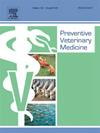Methods to assess on-farm biosecurity in Europe and beyond
IF 2.2
2区 农林科学
Q1 VETERINARY SCIENCES
引用次数: 0
Abstract
The aim of this study was to identify which biosecurity assessment methods (BAMs) are currently used in practice in animal farms. To address this, a structured questionnaire was developed to gather information such as the animal species, main objectives, type of enforcement, output generated and feedback of the result. In the context of the BETTER Cost Action project, country representatives identified in each of their countries which BAMs were used and completed an online survey. The survey was prepared and translated in 23 languages. Besides a descriptive analysis, clusters of BAMs were determined using a multiple correspondence analysis. Responses, collected between December 2022 and July 2023, included 74 BAMs used in 28 countries. Most of them were used in a single country while three were used in multiple countries. This study provides a comprehensive picture of existing BAMs and insights into their diversity, such as variations in objectives, implementation, evaluators, respondents, feedback, or assessment outputs. Moreover, we identified four BAMs clusters differentiated by their objective, evaluator and type of feedback provided. This study might also represent the basis for future research on strengths and weaknesses of different BAMs.
欧洲及其他地区农场生物安全评价方法
本研究的目的是确定目前在动物养殖场实践中使用的生物安全评估方法(BAMs)。为了解决这个问题,我们编制了一份结构化的问卷,以收集诸如动物种类、主要目标、执法类型、产出和结果反馈等信息。在BETTER成本行动项目的背景下,各国代表在各自的国家中确定了使用了bms的国家,并完成了一项在线调查。这项调查是用23种语文编写和翻译的。除了描述性分析外,还使用多重对应分析确定了bam的聚类。在2022年12月至2023年7月期间收集的回复包括28个国家使用的74个bam。其中大多数在一个国家使用,而三个在多个国家使用。本研究提供了现有bms的全面情况,并深入了解了其多样性,例如目标、实施、评估人员、受访者、反馈或评估产出的变化。此外,我们还根据目标、评估者和提供的反馈类型确定了四个BAMs集群。本研究也可为未来研究不同管理模式的优缺点提供基础。
本文章由计算机程序翻译,如有差异,请以英文原文为准。
求助全文
约1分钟内获得全文
求助全文
来源期刊

Preventive veterinary medicine
农林科学-兽医学
CiteScore
5.60
自引率
7.70%
发文量
184
审稿时长
3 months
期刊介绍:
Preventive Veterinary Medicine is one of the leading international resources for scientific reports on animal health programs and preventive veterinary medicine. The journal follows the guidelines for standardizing and strengthening the reporting of biomedical research which are available from the CONSORT, MOOSE, PRISMA, REFLECT, STARD, and STROBE statements. The journal focuses on:
Epidemiology of health events relevant to domestic and wild animals;
Economic impacts of epidemic and endemic animal and zoonotic diseases;
Latest methods and approaches in veterinary epidemiology;
Disease and infection control or eradication measures;
The "One Health" concept and the relationships between veterinary medicine, human health, animal-production systems, and the environment;
Development of new techniques in surveillance systems and diagnosis;
Evaluation and control of diseases in animal populations.
 求助内容:
求助内容: 应助结果提醒方式:
应助结果提醒方式:


